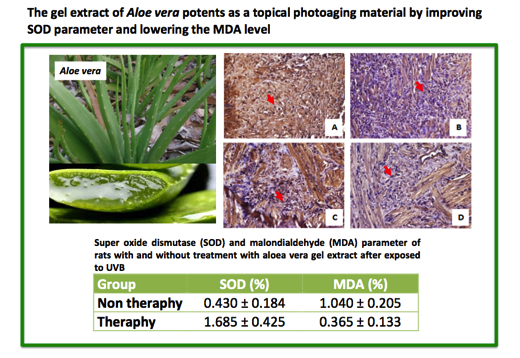Effect of Topical Aplication of Gel Aloe Vera Extract on The UVB-Induced Skin Photoaging in Hairless Rats
Abstract

References
[1] D’Orazio, J., S. Jarret, A. Amaro-Ortiz, T. Scott. Int. J. Mol. Sci, 2013, 14, 12222-12248.
[2] Ichihashi, M., H. Ando, M. Yoshida, Y. Niki, M. Matsui, JAAM, 2009, 6(6), 46-59.
[3] Svobodova, A., D. Walterova, J. Vostalova, Biomed Pap Med Fac Univ Palacky Olomouc Czech Repub, 2006, 150(1), 25-38.
[4] Fisher, G. J., Z. Q. Wang, S. C. Datta, J. Varani, S. Kang, J. J. Voorhees, NEJM, 1997, 337(20), 1419-1428.
[5] Feng, X. X., X. T.Yu, W. J. Li, S. Z. Kong, Y. H. Liu, X. Zhang, Y. F. Xian, X. J. Zhang, Z. R. Su, Z. X. Lin, Eur. J. Pharm. Sci., 2014, 63, 113-123.
[6] Janero, D. R., Free Radical Biol Med, 1990, 9(6), 515-540.
[7] Qadir, M. I., Int J Nat Ther, 2009, 2, 21-26.
[8] R. Rajeswari, M. Umadevi, C. S. Rahale, R. Pushpa, S. Selvavenkadesh, K. P. S. Kumar, D. Bhowmik, J Pharmacogn Phytochem, 2012, 1(4), 118-124.
[9] Sahu, P. K., D. D Giri, R. Singh, P. Pandey, S. Gupta, A. K Shrivastava, A. Kumar, K. D Pandey, Pharmacol Pharm, 2013, 4, 599-610.
[10] Pandel, R., B. Poljšak, A. Godic, R. Dahmane, ISRN Dermatol., 2013, 2013, 1-11.
[11] Wenk, J., P. Brenneisen, C. Meewes, M. Wlaschek, T. Peters, R. Blaudschun, W.Ma, L. Kuhr, L. Schneider, K. Scharffetter-Kochanek, Curr Probl Dermatol, 2001, 29, 83-94.
Refbacks
- There are currently no refbacks.

This work is licensed under a Creative Commons Attribution-NonCommercial 4.0 International License.








